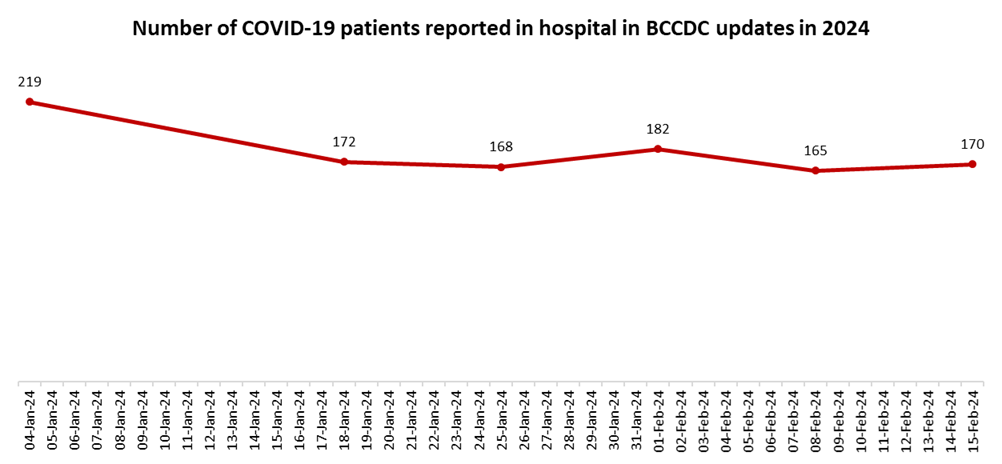B.C. respiratory illnesses mostly stable or declining in latest weekly data
 A sign at the entrance to Surrey Memorial Hospital is seen on Saturday, Feb. 5, 2022. (CTV)
A sign at the entrance to Surrey Memorial Hospital is seen on Saturday, Feb. 5, 2022. (CTV)
The number of people hospitalized with COVID-19 in B.C. was essentially unchanged this week, and key indicators of respiratory disease transmission in the province continue to show mostly stable or declining trends.
There were 170 test-positive COVID patients in hospitals across the province Thursday, up from 165 the week before, but within the same narrow range that has been seen since mid-January.
 The number of COVID-positive patients in B.C. hospitals in public updates from the BCCDC in 2024 is shown. (CTV)
The number of COVID-positive patients in B.C. hospitals in public updates from the BCCDC in 2024 is shown. (CTV)
Other COVID-19 data is also stable or declining in the B.C. Centre for Disease Control's latest weekly update.
According to the BCCDC, there were 391 newly confirmed COVID infections in the province during the most recent epidemiological week, from Feb. 4 to 10. That's down from 441 the week before.
The percentage of tests coming back positive was largely unchanged, however, suggesting the week-to-week decrease was the product of fewer tests conducted. During the week that ended Feb. 10, 10.5 per cent of specimens came back positive. The week before, that percentage was 10.6.
Wastewater surveillance data shows concentrations of SARS-CoV-2 remaining fairly stable at most monitored treatment plants over recent weeks.
It's a similar story when looking at other respiratory illnesses for which the BCCDC shares data.
The most recent epidemiological week saw declines in the number of new positive tests for influenza and RSV (from 455 to 366 and from 324 to 247, respectively), and test positivity rates for each virus also dropped.
During the week that ended Feb. 10, 9.1 per cent of tests came back positive for influenza, down from 9.8 the week before. RSV test positivity dropped from 7.3 per cent to 6.5 per cent over the same period.
Positivity rates for entero/rhinovirus and "other" respiratory illnesses – a category that includes parainfluenza, adenovirus, HPMV and seasonal coronaviruses – rose sharply during the week in question, but those diseases make up small portions of the overall respiratory illness burden in the province. In other words, while the percentage of tests coming back positive for those diseases spiked, the absolute number of positive tests was still relatively small (102 for entero/rhinovirus and 205 for "other").
Similarly, wastewater surveillance data shows increasing concentrations of influenza B at some treatment plants in the Lower Mainland and on Vancouver Island, but levels remain low overall.
Concentrations of influenza A and RSV in wastewater, meanwhile, have been decreasing across the province in recent weeks.
CTVNews.ca Top Stories

More than 115 cases of eye damage reported in Ontario after solar eclipse
More than 115 people who viewed the solar eclipse in Ontario earlier this month experienced eye damage after the event, according to eye doctors in the province.
Toxic testing standoff: Family leaves house over air quality
A Sherwood Park family says their new house is uninhabitable. The McNaughton's say they were forced to leave the house after living there for only a week because contaminants inside made it difficult to breathe.
Decoy bear used to catch man who illegally killed a grizzly, B.C. conservation officers say
A man has been handed a lengthy hunting ban and fined thousands of dollars for illegally killing a grizzly bear, B.C. conservation officers say.
B.C. seeks ban on public drug use, dialing back decriminalization
The B.C. NDP has asked the federal government to recriminalize public drug use, marking a major shift in the province's approach to addressing the deadly overdose crisis.
OPP responds to apparent video of officer supporting anti-Trudeau government protestors
The Ontario Provincial Police (OPP) says it's investigating an interaction between a uniformed officer and anti-Trudeau government protestors after a video circulated on social media.
An emergency slide falls off a Delta Air Lines plane, forcing pilots to return to JFK in New York
An emergency slide fell off a Delta Air Lines jetliner shortly after takeoff Friday from New York, and pilots who felt a vibration in the plane circled back to land safely at JFK Airport.
Sophie Gregoire Trudeau on navigating post-political life, co-parenting and freedom
Sophie Gregoire Trudeau says there is 'still so much love' between her and Prime Minister Justin Trudeau, as they navigate their post-separation relationship co-parenting their three children.
Last letters of pioneering climber who died on Everest reveal dark side of mountaineering
George Mallory is renowned for being one of the first British mountaineers to attempt to scale the dizzying heights of Mount Everest during the 1920s. Nearly a century later, newly digitized letters shed light on Mallory’s hopes and fears about ascending Everest.
Loud boom in Hamilton caused by propane tank, police say
A loud explosion was heard across Hamilton on Friday after a propane tank was accidentally destroyed and detonated at a local scrap metal yard, police say.






























